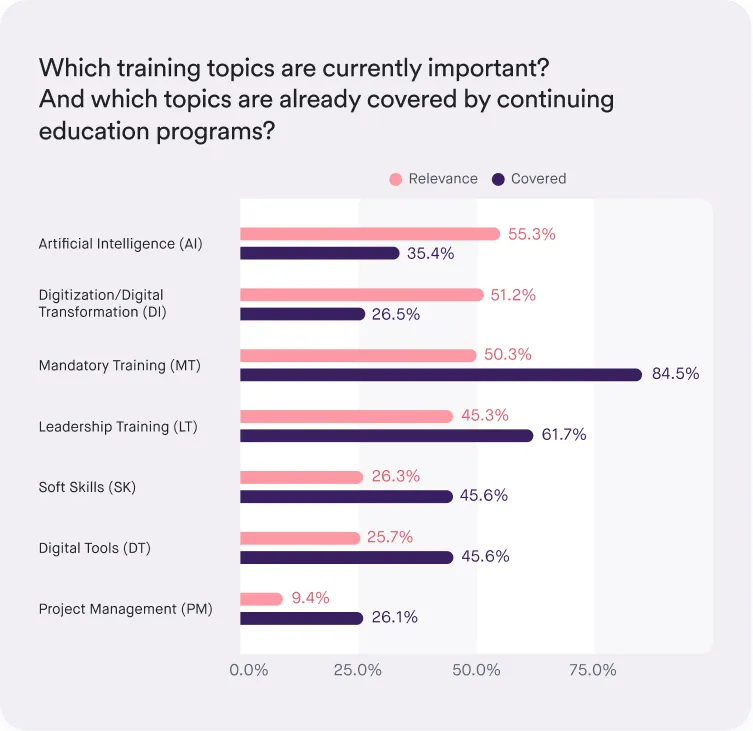
While everyone is discussing AI and digitalization, few are addressing how to prepare employees for these changes. The demand for continuing education is growing faster than many human resources departments can respond. It is time to take a closer look: Where are the biggest gaps, and how can they be addressed?
- Many companies see the need for future skills (AI, digitalization) but rarely act on it.
- Learning and development are now strategic imperatives, not optional perks.
- Most lack structure, digital platforms, and a forward-looking training strategy.
- A clear 5-step approach helps identify real training needs effectively.
- Firms that make learning a core strategy gain lasting innovation and competitiveness.
Why Upskilling Has Become a Strategic Imperative
Artificial Intelligence, digital tools, new ways of working — employee skill requirements are changing faster than ever. What was “future-proof” yesterday may already be outdated tomorrow.
For businesses, this means professional development is no longer a “nice-to-have.” It’s a decisive factor for competitiveness. To stay innovative and agile, organizations must invest in their people — and the best time to start is now.
But in practice, there’s often a gap between knowing and doing.
- According to the Digital Office Index, 60% of German companies lack employees with the digital skills needed to drive transformation.
- A Microsoft survey found that only 44% of workers use AI at least once a month for their job — while 21% still need basic introductions to the technology.
- And the Digitalization in SMEs report revealed that 45% of mid-sized German firms don’t even have a digital learning platform.
Most companies know they need to invest more in digital skills — but many still aren’t doing it. Why?
Identifying Training Needs: Why So Many Companies Are Flying Blind
Many organizations lack a clear picture of which skills they’re actually missing. Mandatory training programs are usually covered, but future-oriented competencies — such as AI, digitization, and data literacy — often fall through the cracks.
The core issue: training needs are often based on past challenges instead of future ones.
Instead of asking, “What skills will we need two years from now?”, companies focus on today’s demands — and fall further behind with every technological shift.
The L&D Report 2025: “Changing Training Needs” (German) confirms this: while many companies recognize the importance of AI, only a small fraction offer suitable training programs.

How to Determine Training Needs in 5 Steps
Assessing training needs isn’t a matter of company size — it’s a matter of method. These five steps help you identify what your organization truly requires:
- Define future skill demands – Which competencies will matter most in 12–24 months?
- Take stock of current capabilities – Which skills already exist, and where are the gaps?
- Set priorities – Which topics have the biggest impact on strategy, productivity, and innovation?
- Engage employees – Gather feedback from teams to design relevant, practical training.
- Plan concrete actions – Choose the right formats, structure content, and allocate resources.
From Needs to Action: Making Learning Stick
Identifying needs is one thing — turning them into action is another. A clear understanding of what’s missing is useless without a matching learning offer.
The most successful organizations approach learning strategically. They:
- build digital learning infrastructures that make learning accessible anytime, anywhere,
- combine compliance and future skills into holistic learning paths, and
- foster a continuous learning culture instead of relying on one-off workshops.
That’s how learning becomes part of the company’s DNA — not just another HR project.
L&D Report 2025: High Ambition, Weak Foundations
The L&D Report 2025 (German) by Masterplan and Amadeus Fire shows:
Around two-thirds of companies name AI as a top priority — yet only about one-third currently offer related training.
This highlights a central dilemma: many organizations want to promote future skills but simply aren’t equipped to do so. They lack digital learning platforms, scalable formats, or the time and resources to create new programs.
The result: the desire for upskilling exists, but the infrastructure doesn’t. Without solid foundations, learning remains reactive instead of proactive.
Closing the Learning Gap: From Intention to Strategy
The good news: bridging the gap is absolutely achievable. Successful companies follow a clear roadmap:
- Regularly assess training needs – through surveys, skill analyses, and scenario planning.
- Build a digital learning infrastructure – with a central platform that unifies content and tracks progress.
- Prioritize future skills – such as AI, digitalization, project management, and soft skills.
- Foster a learning culture – empower leaders as role models and promote learning as an ongoing process.
With the right strategy, learning evolves from a cost center into a competitive advantage — and a cornerstone of long-term success.
Conclusion: Learning as the Key to Future Readiness
Professional development is no longer an optional perk — it’s a strategic necessity.
Organizations that understand their training needs and provide the right opportunities not only boost innovation, but also strengthen employee motivation and retention.
Many companies already know which skills will shape the future — but too few are taking decisive action. Those that close the gap between ambition and execution today will build stronger teams and ensure their organization’s long-term resilience.
Across the DACH region, one message is clear:
It’s time to think about learning strategically — before your competitors do.
